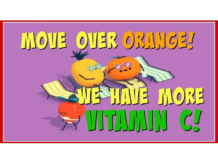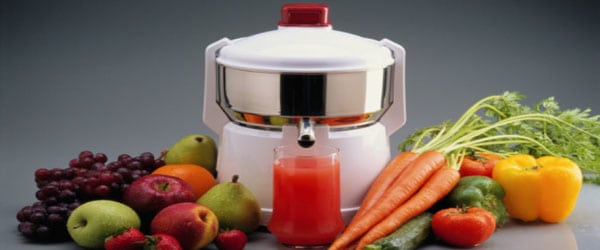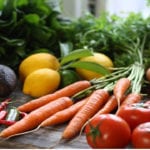Juicing is a very powerful tool that you can use to accelerate your progress towards optimal health. Virtually every health authority, even conventional doctors, recommend 6-8 servings of vegetables and fruits per day but very few of us actually get that. In my life I have found that juicing is a simple and easy way to virtually guarantee that you will reach your daily target for vegetables.
I first became excited about juicing when I was in practice and treated a patient who was in her 60s or maybe even 70s but looked like she was in her 40s. She attributed most of her youthful appearance to juicing. I decided to try it and have been juicing more or less regularly ever since. I typically juice every day and consume from a pint to a quart of green juice daily.
Reasons to Juice
There are three main reasons why you will want to consider incorporating vegetable juicing into your optimal health program:
1. Juicing helps you absorb most of the nutrients from the vegetables. This is important because most of us have impaired digestion as a result of making less-than-optimal food choices over many years. This limits your body’s ability to absorb all the nutrients from the vegetables. Juicing will help to “pre-digest” them for you, so you will receive most of the nutrition, rather than having it go down the toilet.
2. Juicing allows you to consume an optimal amount of vegetables in an efficient manner. If you are a carb type, you should eat one pound of raw vegetables per 50 pounds of body weight per day. Some people may find eating that many vegetables difficult, but it can be easily accomplished with a quick glass of vegetable juice.
3. You can add a wider variety of vegetables in your diet. Many people eat the same vegetable salads every day. This violates the principle of regular food rotation and increases your chance of developing an allergy to a certain food. But with juicing, you can juice a wide variety of vegetables that you may not normally enjoy eating whole.
Healing Through Juicing—The Juice Lady’s Story
Cherie Calbom earned her nickname “The Juice Lady” back in 1991, when she worked for the Juiceman company. But she’s been passionate about juicing far longer. She also has a Masters Degree in Whole Foods Nutrition from Bastyr University.
“I got into juicing way back, long before I got into school in Whole Foods Nutrition. I, years ago, had chronic fatigue syndrome; fibromyalgia in my late 20s; hypoglycemia; allergies; candidiasis—a long list of problems and no hope to get well,” Cherie says.
“I decided I was going to find a way; there had to be a way to get well. So I started going to health food stores and reading. I found an old Norman Walker book… So I thought, okay I’m going to design my own program. I got my first juicer and I embarked on this five day vegetable juice cleanse, and continued that through three months of juicing. I changed my diet completely.One morning, I woke up and thought somebody gave me a new body in the middle of the night. It was like WOW! I felt completely healed.”
However, it bears mentioning that it wasn’t an entirely smooth ride.
“Along the way, I felt worse before I felt better. No one had talked about the detox reactions. My dad kept saying, “I think you’re killing yourself with this juice program.”…I was definitely detoxing.”
In Cherie’s case, it took three months before she finally, and then suddenly, felt completely renewed. Another big clue that her health problems were due to toxic overload came when she slowly started adding some of the junk food back in. Her symptoms then reappeared.
Interestingly, three months is also the average lifespan of red blood cells. So in three months you should have renewed most all of your red blood cells. In Cherie’s experience, this is the typical time frame for most people before they see any dramatic improvement in their health.
Juicing for Weight Management and Diabetes
Cherie’s second book, The Juice Lady’s Turbo Diet, is in large part oriented towards obesity, which is one of the primary health challenges here in the US. Technically, more than a third of American adults are obese, and nearly 80 percent of Americans are overweight! These are staggering statistics.
Excessive fructose consumption is a major contributing factor. Most processed foods and beverages contain high fructose corn syrup (HFCS), and the number one source of calories in the US is soda… Then of course there’s obviously a lack of exercise.
“I wrote The Turbo Diet because of that,” Cherie says. “Because I started noticing when people got on this program they were losing weight, even though people often came to me for other issues… So I started looking at what is going on.
And then there were two studies last year, I believe it was, Baylor College of Medicine UC Davis, Vegetable Juicing and Weight Loss, and they found that the people who included two glasses of vegetable juice a day lost four times the weight of the non-juice drinkers. So I thought that was rather interesting and significant…
In one of the studies, the majority of the people in it had metabolic syndrome; insulin resistance. I found that very interesting because that’s a tougher one to work with and still see weight loss results… Then I really got excited and that’s when I put this book together, giving people the whole program of how to integrate it into your lifestyle, menu plan, shopping list, recipes and what’s going on. Since that time, I’ve heard from people all across the country who have said, they’ve given this a try and they’re losing weight where nothing was working for them before.”
Important Dietary Factors: Low Glycemic Foods and Coconut Oil
An important part of the diet Cherie recommends in her book is the focus on low glycemic foods. Cherie essentially combined the diabetic diet with vegetable juicing. According to Cherie, this combination has been the most effective for people with insulin resistance, metabolic syndrome, or diabetes.
She also recommends including coconut oil, as it too can help with weight loss. You could do as much as three tablespoons of coconut oil a day as a therapeutic dose to kill excessive yeast, although you may need to work your way up to that amount. Your level of tolerance depends on how well your liver functions as it is a fat. But it may be too many calories for some people, as three tablespoons would give you about 400 calories just from coconut oil.
Additionally, many individuals who chose to be a vegetarian or vegan will have dangerously low cholesterol levels and coconut oil can be very effectively used to increase cholesterol levels. If you already have high cholesterol levels though it is not dangerous unless you take very large quantities.
Cherie recommends using about one teaspoon to one tablespoon a day, and to also use it for cooking, in lieu of other cooking oils or butter.
Last but not least, the program calls for juicing twice a day. If you’re diabetic, hypoglycemic or insulin resistant, focus on dark greens. Cherie also recommends diluting all your juices, but not with water. Instead, use cucumbers to increase the water content of your juice because it also contains some nutrients. You’ll also avoid any and all potential toxins, such as fluoride, in your tap water.
Juicing for Your Nutritional Type
According to Nutritional Typing principles, if you are a carb type, vegetable juicing is STRONGLY recommended. With patients in our clinic, we strongly encourage it if they expect to regain their health. If you are a mixed type, it is certainly useful to juice.
However, protein types need to follow some specific guidelines to make it work for them. Celery, spinach, asparagus, string beans and cauliflower would be your best vegetables to juice. You can add some of the dark deep leafy greens like collards, kale, and dandelion greens but do so cautiously and pay careful attention to how you feel..You may also want to initially limit your serving size of juice to no more than 6 oz., and store it properly and drink smaller amounts throughout the day.
Also, to make drinking vegetable juice compatible with protein type metabolism (which needs high amounts of fat), it is important to blend a source of raw fat into the juice. Raw cream, raw butter, raw eggs, avocado, coconut butter, or freshly ground organic flax or hemp seeds are the sources of raw fat that we most recommend. In addition to adding a source of raw fat to your juice, you may also find that adding some, or even all, of the vegetable pulp into your juice helps to make drinking the juiced vegetables more satisfying.
How Proper Nutrition Curbs Hunger and Cravings
Amazingly, many people still don’t understand that when your body is well nourished, your appetite goes down. Chronic hunger is often a sign that your body is starved for nutrients.
Cravings can also be a sign of something awry. For example, sugar and carb cravings are typical signs of candidiasis—it’s really the yeast signaling it wants more food, and yeast feeds on sugar. Oftentimes you’ll also crave what you’re allergic to.
This is where juicing can be very helpful, as you’re getting plenty of complementary nutrients. If you’re juicing for weight loss, Cherie recommends a minimum of 16 ounces of juice a day. Ideally, you’ll want to strive for a full quart of juice, split up between the morning and the afternoon.
“Instead of coffee or something sweet, why not have a glass of juice?” Cherie suggests. “It picks your body back up and you’ve got sustaining energy for the rest of your day, or just before dinner if you want to cut down on your appetite; cut that real strong hunger just before dinner.”
If you’re going to juice that much, my personal recommendation would be to juice it all at once, to save time. Then use a FoodSaver, or at least put it in a glass jar filled to the very top so there is no oxygen, and put it in the fridge immediately. You’re probably going to retain well over 90 percent of the nutritional value if you do it in that way and consume it within 12 hours
What To Do with the Pulp?
Many are concerned about wasting the pulp and throwing it away. Well that can easily be solved by composting it into your vegetable or ornamental garden. However, an even better solution would be to eat it. From a nutritional perspective it is far more useful to eat the whole vegetable as the fibers actually serve as a prebiotic and raw fuel for your good bacteria to grow, and as a weed killer that actually helps to eradicate harmful organisms like yeast and pathogenic bacteria.
You are probably thinking “how disgusting,” and “why would I ever want to do that?”
Well if you dress up the pulp with some Himalayan salt and other condiments that you may enjoy, like balsamic vinegar and crushed red peppers, it becomes far more palatable. What I have recently figured out though is if I put a few lightly poached eggs over the pulp with some melted fresh raw organic butter, it really is turns it into a delicious meal.
The butter and eggs provide fat and protein that actually balance out the meal. I used to feel hungry after juicing but since I started eating the pulp with poached eggs I feel very full and satisfied.
Some might ask why I don’t just use a powerful mixer like a Vita Mixer and have less mess to clean up and prepare it quicker. Well there are several problems doing it this way as the speed of the Vita Mixer is too high and will actually damage some of the nutrients in the vegetables.
More importantly is it is MUCH less palatable as it becomes a thick, virtually undrinkable slurry rather than a tasty meal and refreshing thin juice you can drink right down. More importantly, the bulk of the nutrition is in the juice NOT the fiber. I consume one quart of vegetable juicer per day which is several pounds of vegetables. I can strongly assure you that while it is possible to consume as much with a Vitamixer most people will not as the fiber will fill them up far before they reach that point. When I do consume the pulp from my juicer, it is only a small fraction of all the pulp that is produced.
Adding Spice and Flavor to Your Juice
Recipes, of course, are a key factor, as is selecting appropriate vegetables for your nutritional type. Because although vegetables, overall, are brimming with healthful nutrition, your body will thrive on different vegetables depending on your personal biochemistry.
Celery and cucumbers can form the bulk of your juice; they’re what provide you with the majority of the water. Cherie recommends leaving the skins on organic cucumbers if you like, which make them easier to juice. Then add the deep dark greens and rotate those as you feel the need to. At the end of this article, I’ll offer additional suggestions of good vegetables to get you started.
The KEY to Countering the Bitterness of Many Greens
If you need some sweeteners you can either use liquid stevia or some frozen cranberries. Frozen cranberries are fairly sweet but still low in sugar. They’re also beneficial for your kidney and bladder. For some spice (watch our spice video), add a little fresh ginger. And two classics to cut bitterness are limes. Get the organic ones and you can merely cut up the limes and juice the whole fruit, skin and all. Interestingly, limes are virtually fructose free.
For those who still struggle with the taste you can add some liquid flavored stevia. My favorite is French Vanilla and English Toffee. Be careful to avoid adding fruits like apples to sweeten the taste as most fruits are high in fructose.
Getting Started with Juicing
First, you need a good juicer. High speed blenders like Vitamix are wonderful tools and they’re great for green smoothies, but they are NOT juicers.
You have a world of options when it comes to juicers, starting below $100 on the low end. You start getting into better quality juicers around $150. There are a number of different types of juicers, from fast spinning centrifugal juicers to slow-moving masticating juicers. The slower the juice is extracted, the more nutrients are preserved.
The type of juicer you choose is of course up to you. When looking at your options, remember to evaluate the cleanup required, as this could influence your willingness to use it every day. As Cherie says, “In the end, the best juicer is the one you’ll actually use.”
So a MAJOR issue will be how easy it is too clean up. If the cleanup is too long or complex and you have an aversion to cleaning it then you will simply not juice, so please factor that into your decision making process before you choose a juicer. Next, you need a good recipe; something that tastes great, or else you’ll likely quit before you’ve really gotten started.
“Add in some dark greens because that’s so wonderful for your health,” Cherie suggests. “I use coloreds and Swiss chard, kale, parsley. I combine that with cucumber and celery. But if you’ve never juiced before, then you want to add in some flavorful things; a little bit of carrot. Some lemon is wonderful. It really improves the taste. I add lemon too almost everything I make.”
Beginner’s Guide to Great-Tasting Juice
The order listed below is only intended for those who are new to juicing. It’s designed to make you have a pleasant experience with it. However, if you add a lime to the juice you can start experimenting with the more bitter greens early on, as the lime effectively counters their bitterness. Or as mentioned earlier you can add some flavored liquid stevias.
Please note it would be FAR better to use limes than carrots, beets or apples, which have far more fructose than limes.
Step 1: If you are new to juicing. I recommend starting out with these vegetables, as they are the easiest to digest and tolerate:
•Celery
•Fennel (anise)
•Cucumbers
These three aren’t as nutrient dense as the dark green vegetables. Once you get used to the 3 vegetables listed above, you can start adding the more nutritionally valuable, but less palatable, vegetables into your juice.
Step 2: When you’ve acclimatized yourself to juicing, you can start adding these vegetables:
•Red leaf lettuce
•Green Leaf lettuce
•Romaine lettuce
•Endive
•Escarole•Spinach
Step 3: After you’re used to these, then go to the next step:
•Cabbage
•Chinese Cabbage
•Bok Choy
An interesting side note: Cabbage juice is one of the most healing nutrients for ulcer repair as it is a huge source of vitamin U.
Step 4: When you’re ready, move on to adding herbs to your juicing. Herbs also make wonderful combinations, and here are two that work exceptionally well:
•Parsley
•Cilantro
You need to be cautious with cilantro, as many cannot tolerate it well. If you are new to juicing, hold off on the cilantro. These are more challenging to consume, but they are highly beneficial.
Step 5: The last step: Only use one or two of these leaves, as they are very bitter:
•Kale
•Collard Greens
•Dandelion Greens
•Mustard Greens (bitter)
When purchasing collard greens, find a store that sells the leaves still attached to the main stalk. If they are cut off, the vegetable rapidly loses many of its valuable nutrients.




























